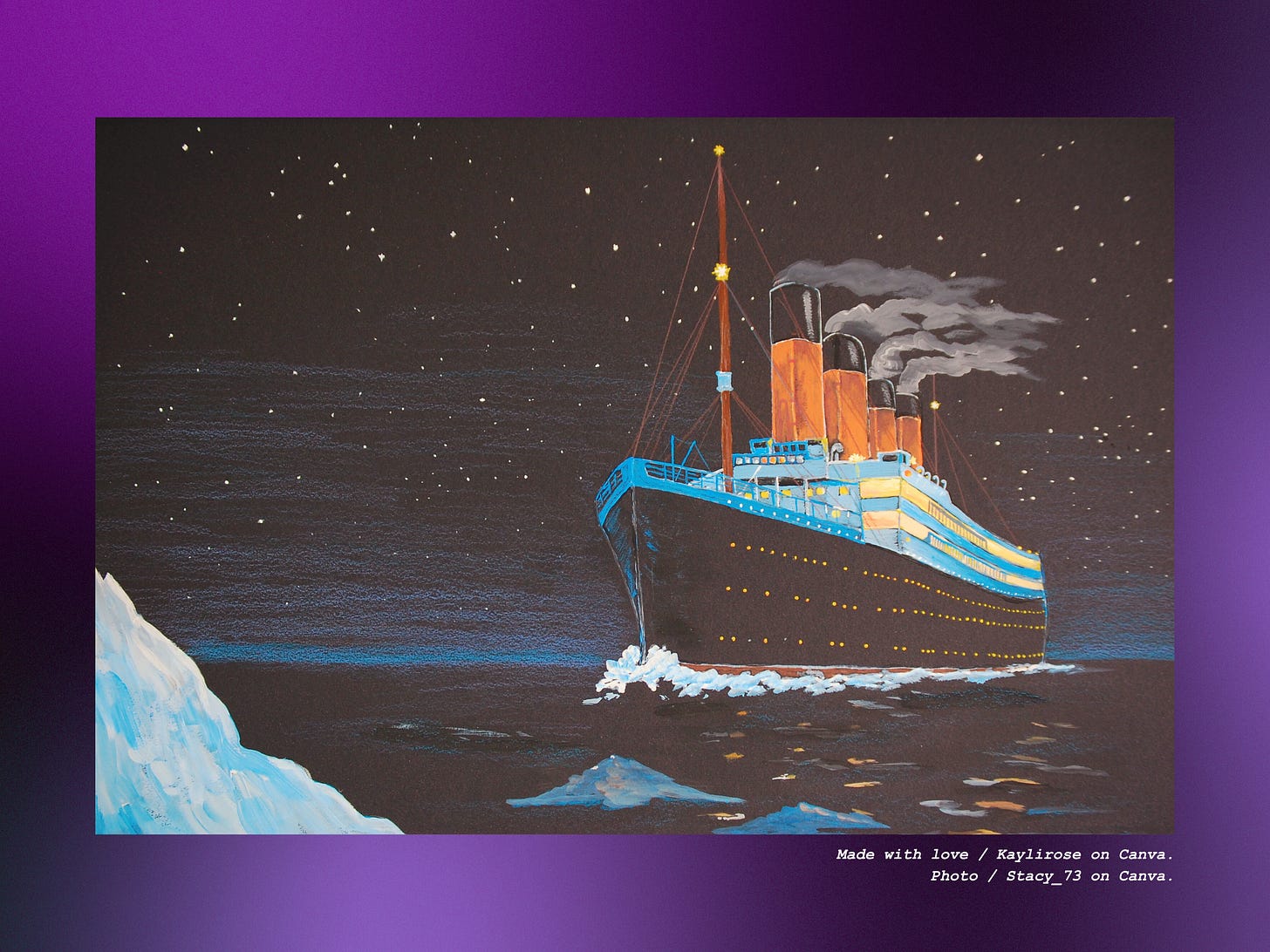I’m begging you to care about this giant boat (Pt. I)
The Titanic was my first hyperfixation, and we, me + you, are going to talk about it right now.
I think about the Titanic all the time. The class divide. The chaos. The “what ifs.” The people who stayed behind. Maybe it’s the tragedy, the symbolism, or maybe it’s just how my brain latches onto things and never lets go. The Titanic lives rent free in my head, and it should live rent free in yours, too.

Why should you care about the Titanic? Because it’s history, and history sticks around. The Titanic still shows up in our conversations, our media, even our headlines.
I mean, it clearly still holds cultural weight. In June 2023, people paid thousands to dive down in OceanGate, despite every expert basically saying, “Hey, maybe don’t.” And after multiple casualties, they’re trying to go back down… again? Like… have we learned nothing? Clearly, we need another history lesson.
Just to be clear: being obsessed with the Titanic doesn’t mean I support that kind of stuff. I would never pay to sit in a tin can and go bother the dead. The ship is spectacular, but let it rest. It’s a gravesite, not an attraction.
Besides, the Titanic is literally deteriorating as we speak. That’s what happens to things in the ocean. They break down faster than on land. Nature is doing what it does best.
If you’re that desperate to see the Titanic, go play one of those ship-sinking servers on Roblox. They’ve got surprisingly solid replicas that don’t risk mortal peril or moral bankruptcy.
But if you’d rather read about the Titanic in an intelligent, girly-pop tone, with a side of ADHD hyperfixation. Then this is your story.
Let’s just say the vibes were off
The Titanic’s “unsinkable” reputation came from its supposed safety features — mainly, 16 compartments that could be sealed off from the bridge. The idea? If the hull cracked or took on water, these watertight compartments would keep the ship afloat.
Here’s the problem: they assumed the compartments were watertight.
WRONG.
According to Brittanica, the bulkheads (a fancy word for the walls between those compartments) “were not capped at the top.” Meaning water could literally spill over from one compartment to the next.
It didn’t help that the builders claimed the ship could stay afloat even if four compartments flooded. (Spoiler alert: more than four did.) To quote Brittanica, “The system led many to claim that the Titanic was unsinkable.”
So, on April 10, 1912, the Titanic set sail from Southampton, England, bound for New York. On board were about 2,200 people, roughly 1,300 of them passengers, completely unaware they were part of one of history’s most cautionary tales.
Here’s the thing: the people aboard the ship were set up for disaster before the iceberg.
In Disaster Prevention: Lessons Learned from the Titanic by James Battles, published by the National Library of Medicine, he writes:
“The Titanic has become a metaphor for a disaster waiting to happen. It's part of our mythology, and we continue to find it fascinating. We can learn a great deal from the Titanic disaster.”
Battles explains that the Titanic had just 16 lifeboats — only half of what was needed to save everyone on board. The ship would have needed 32. But the shipowners opposed the change, saying it would be too expensive.1
(Side note: this is why modern cruise ships have rules. This is also your reminder on why you should follow them. Seriously. Don’t be an idiot.)
What’s worse? The designers actually planned for extra lifeboats. But White Star Line chairman Bruce Ismay wasn’t into the idea. He thought they would shrink the promenade deck, which he saw as a bigger issue than, you know… Mass death.
To quote Battles again:
“He thought it was more important to pamper the first-class passengers on this floating palace (for which tickets were $500,000 each in today’s money) rather than prepare for a disaster that would ‘never happen’ on a ship with the Titanic’s technology.”
So yeah, before everything went horribly wrong, life aboard the Titanic was… honestly, kind of popping — if you were rich. While below deck, second and third class passengers lived a very different experience. But many were still buzzing with excitement. For a new life in America and whatever came next. No one knew what was coming
Did they not listen?
By April 14, 1912, the Titanic had been at sea for four days. Spirits were high, the ocean and weather were unusually calm, and the ship was making good time across the Atlantic.
But what people didn’t know was that this part of the North Atlantic had way more icebergs than usual. In the years leading up to 1912, unusually warm weather caused Greenland’s glaciers to melt faster, sending massive chunks of ice drifting farther south than normal.
On top of that, the atmosphere over the sea had unusually high pressure, creating eerily calm weather. The skies were clear. The ocean was still.2
Too still.
And finally, the last doomed factor. According the Woods Hole Oceanographic Institution3, survivors described the sea that night as “like glass.”
No waves meant no white water breaking at the base of icebergs. And no waves meant no way the spotters could tell what was an iceberg and what wasn’t. They were doomed before they left the dock, and before they almost made it ashore.
Everything looked calm. Peaceful, even. But the universe twistedly said, “psych.”
Next time, we talk about what happened after 11:40 p.m., the moment the iceberg hit. What people saw, felt, and feared. And how a calm night turned into one of the most devastating maritime disasters in history.
(So like… grab a snack or something. It’s gonna be a long read.)
Until then, stay hydrated and stay cool.
Also, if you’re enjoying the free articles, keep an eye out for paid content. Word on the street is… something might be coming soon.
— Kaylirose 💜✨
Credit ⛓️💥
Sources are linked in-text, have footnotes, or listed below. Because even doomed ships deserve proper citation.
Disaster prevention: lessons learned from the Titanic / James Battles, National Library of Medicine.
History of RMS Titanic / Woods Hole Oceanographic Institution.
The Sinking of the RMS Titanic (1912) / Climate in Global Cultures and Histories: Promoting Climate Literacy Across Disciplines.
Titanic / Brittanica.
“At the time, the British Board of Trade had lifeboat requirements based on the tonnage of the ship and not the number of people.” / Disaster prevention: lessons learned from the Titanic. James Battles, National Library of Medicine.
Credit / The Sinking of the RMS Titanic (1912). Climate in Global Cultures and Histories: Promoting Climate Literacy Across Disciplines.
“The sea was unusually calm and flat, "like glass" according to many survivors. The lack of waves made it even more difficult to spot icebergs, since there was no telltale white water breaking at their edges.” / History of RMS Titanic. Woods Hole Oceanographic Institution.










Even though we all know how the story ends, the way you described the environment that created the tragedy is so thrilling. After more than 100 years later, of course we look back on it and think both the builders, crew and passengers were putting too much faith in advertisement. But we’ve certainly fallen victim to promises of state of the art technology before, just look at Ocean Gate and teslas
I love your writing voice! It’s like listening to a friend explain something they are really excited about sharing with. I could feel your passion for the Titanic in your writing like I was feeling the thump of a bass beat. You also taught me something new. I didn’t realize the compartments weren’t water tight. I’m looking forward to reading more of your writing. Great job!